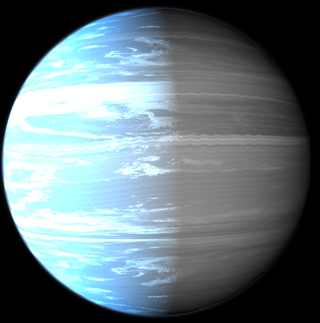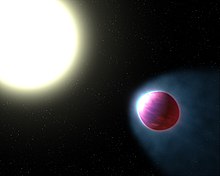
Hot Jupiters are a class of gas giant exoplanets that are inferred to be physically similar to Jupiter but that have very short orbital periods. The close proximity to their stars and high surface-atmosphere temperatures resulted in their informal name "hot Jupiters".

HD 189733 b is an exoplanet in the constellation of Vulpecula approximately 64.5 light-years away from our Solar System. Astronomers in France discovered the planet orbiting the star HD 189733 on October 5, 2005, by observing its transit across the star's face. With a mass 11.2% higher than that of Jupiter and a radius 11.4% greater, HD 189733 b orbits its host star once every 2.2 days at an orbital speed of 152.0 kilometers per second, making it a hot Jupiter with poor prospects for extraterrestrial life.

WASP-6b, also named Boinayel, is an exoplanet approximately 650 light years away in the constellation Aquarius. It was discovered in 2008, by the WASP survey, by astronomical transit across its parent star WASP-6. This planet orbits at only 4% of the Earth-Sun distance. The planet has a mass half that of Jupiter, but its insolation has forced a thermal expansion of its radius to greater than that of Jupiter. Thus, this planet is an inflated hot Jupiter. Starspots on the host star WASP-6 helped to refine the measurements of the mass and the radius of the planet.

WASP-17b is an exoplanet in the constellation Scorpius that is orbiting the star WASP-17. Its discovery was announced on 11 August 2009. It is the first planet discovered to have a retrograde orbit, meaning it orbits in a direction counter to the rotation of its host star. This discovery challenged traditional planetary formation theory. In terms of diameter, WASP-17b is one of the largest exoplanets discovered and at half Jupiter's mass, this made it the most puffy planet known in 2010. On 3 December 2013, scientists working with the Hubble Space Telescope reported detecting water in the exoplanet's atmosphere.
WASP-33b is an extrasolar planet orbiting the star HD 15082. It was the first planet discovered to orbit a Delta Scuti variable star. With a semimajor axis of 0.026 AU and a mass likely greater than Jupiter's, it belongs to the hot Jupiter class of planets.

WASP-43b, formally named Astrolábos, is a transiting planet in orbit around the young, active, and low-mass star WASP-43 in the constellation Sextans. The planet is a hot Jupiter with a mass twice that of Jupiter, but with a roughly equal radius. WASP-43b was flagged as a candidate by the SuperWASP program, before they conducted follow-ups using instruments at La Silla Observatory in Chile, which confirmed its existence and provided orbital and physical characteristics. The planet's discovery was published on April 14, 2011.
WASP-121, also known as CD-38 3220, is a magnitude 10.4 star located approximately 858 light-years away in the constellation Puppis. WASP-121 has a mass and radius similar to the Sun's. It hosts one known exoplanet.

WASP-31b is a low-density (puffy) "hot Jupiter" extrasolar planet orbiting the metal-poor dwarf star WASP-31. The exoplanet was discovered in 2010 by the WASP project. WASP-31b is in the constellation of Crater, and is about 1305 light-years from Earth.
WASP-79b, also known as Pollera, is an extrasolar planet orbiting the star CD-30 1812. This planet is in the constellation Eridanus, and is about 810 light-years from Earth.

WASP-76b is an exoplanet classified as a Hot Jupiter. It is located in the constellation Pisces and orbits its host star, WASP-76, at a distance of approximately 0.033 astronomical units (AU). The orbital period of WASP-76b is approximately 1.8 days. Its mass is about 0.92 times that of Jupiter. The discovery of WASP-76b took place on October 21, 2013, and it is currently the only known planet in the WASP-76 system as of 2022. The equilibrium temperature of WASP-76b is estimated to be around 2,190 K, However, the measured daytime temperature is higher, reaching approximately 2,500 ± 200 K.
WASP-52 is a K-type main-sequence star about 570 light-years away. It is older than the Sun at 10.7+1.9
−4.5 billion years, but it has a similar fraction of heavy elements. The star has prominent starspot activity, with 3% to 14% of the stellar surface covered by areas 575±150 K cooler than the rest of the photosphere.
WASP-75 is a F-type main-sequence star about 980 light-years away. The star is much younger than the Sun at approximately 2.9±0.2 billion years. WASP-75 is similar to the Sun in its concentration of heavy elements.
WASP-88 is a F-type main-sequence star. Its surface temperature is 6450±61 K. WASP-88 is similar to the Sun in its concentration of heavy elements, with a metallicity Fe/H index of 0.03±0.04, and is younger at an age of 3.0±1.3 billion years.
WASP-80 is a K-type main-sequence star about 162 light-years away. The star's age is much younger than the Sun's at 1.352±0.222 billion years. WASP-80 is similar to the Sun in concentration of heavy elements, although this measurement is highly uncertain.
WASP-103 is an F-type main-sequence star located 1,800 ± 100 light-years away in the constellation Hercules. Its surface temperature is 6,110±160 kelvins (K). The star's concentration of heavy elements is similar to that of the Sun. WASP-103 is slightly younger than the Sun at 4±1 billion years. The chromospheric activity of the star is elevated due to interaction with the giant planet on a close-in orbit.

WASP-96b is a gas giant exoplanet. Its mass is 0.48 times that of Jupiter. It is 0.0453 AU from the class G star WASP-96, which it orbits every 3.4 days. It is about 1,140 light-years away from Earth, in the constellation Phoenix. It was discovered in 2013 by the Wide Angle Search for Planets (WASP).













